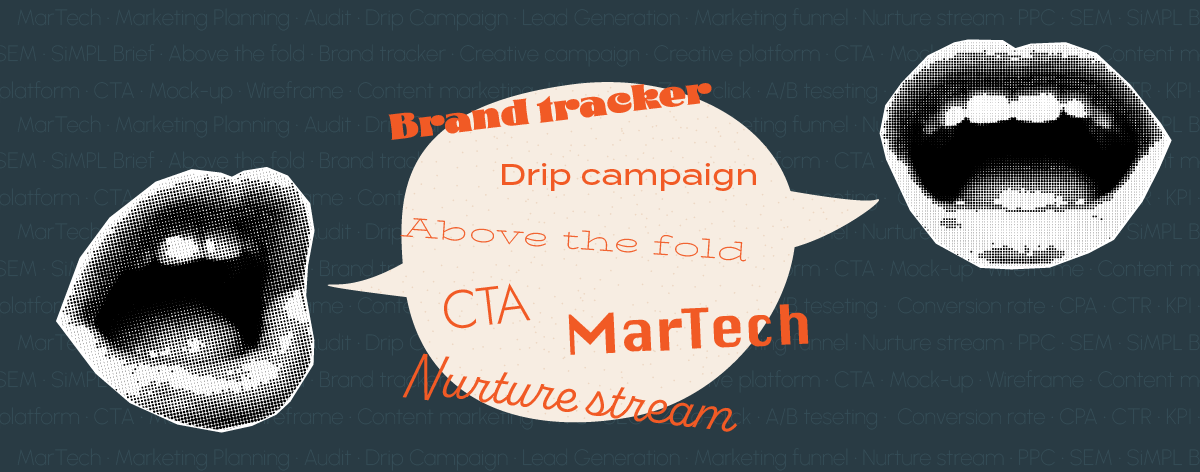When was the last time you brushed up on your marketing lingo? Or saw a marketing acronym you didn't quite recognize? In B2B marketing, where new terms are constantly coined and language is ever evolving, staying up to date keeps you competitive and ready to effectively articulate your next marketing solution.
Use this blog as a refresher of terms and abbreviations across all marketing processes (planning, creative, content, and measurements of success) to cover every marketing base.
Your marketing lingo pick-me-up is below!
Marketing Planning
Audit
When redesigning a website, refreshing marketing tactics or onboarding a new client, we’ll perform an evaluation of all current materials to see what’s working and what can be improved. We’ll look at goals, objectives, strategies, current marketing or brand activities and even competitors to make recommendations on how, what, where and why to optimize.
Discovery
We’re a curious bunch here at LoSasso. That’s why the first phase of our marketing relationship with a new client is all about getting to know one another—we call it discovery. During this time, we’ll conduct initial research to get a better understanding of the product or services, market(s), customers and competitors. And if you’re thinking this is a good time for an audit, you’re already thinking like a marketer!
Drip campaign
A drip campaign is a series of automated emails designed to guide users. They are scheduled at regular intervals during a key point in the journey to convert leads, onboard new customers, provide details leading up to a trade show and so on. Unlike nurture streams, drip campaigns are more about encouraging an action versus nurturing a behavior.
Lead Generation
Lead Generation (or lead gen for short) is usually one of our main objectives for campaigns. In a nutshell, it’s the process of helping to build further interest in a product or service among potential customers—ultimately, turning those leads into customers. We do this with digital paid campaigns, gated content, nurture streams and so on.
Marketing funnel
If you’ve worked in marketing, you’ve most likely heard colleagues refer to the top, middle or bottom of the funnel. That funnel is a marketing funnel and it symbolizes a prospect’s journey from not knowing your brand to loving it. The top is wider because you’re casting a larger net to reel potential buyers in. The middle starts to narrow as you coax them down the funnel. And the bottom is where you seal the purchase deal.
MarTech
Marketing technology, or “martech,” blends marketing strategy and technology using platforms like web analytics to help you stay streamlined and dialed into your marketing goals. In a competitive digital-ad age, martech is crucial in optimizing your overall performance.
Nurture stream
Like a drip campaign, a nurture stream is a series of emails that “nurture” leads throughout the buyer’s journey. However, these emails tend to be more targeted based on behaviors at each stage and will include more educational or brand content to build trust and confidence—and a relationship with the brand. We use this method for high-consideration products or services that require more research or comparisons.
PPC
Pay-per-click (PPC) advertising is a type of SEM (see below), where the advertiser pays for each click that their ad receives. PPC ads are used to direct traffic to a website and are often found at the very top of SERPs. Our digital team relies on a strong grasp of the creative and technical elements of PPC optimization to keep our clients ahead of the competition.
SEM
Search engine marketing (SEM) brings together many of our digital capabilities (e.g., keyword research and data analysis) and uses paid efforts to improve a brand’s presence on search engine results pages (SERPs).
SiMPL Brief
Pulling off the perfect creative brief can be intimidating. It should set up the need for the project, what should be communicated and how it will be measured. The goal is to inspire your creative team while providing some structure for everyone to succeed. Our key to success? We’ve broken it down into five “SiMPL” terms.
Creative
Above the fold
To get noticed, you want your message to be front and center, and that means “above the fold” when it comes to websites. The term refers to the prime space of real estate on a web page that appears on the screen before a user needs to scroll down—usually around 600 pixels.
Brand tracker
In a fast-paced marketing environment, being “in the know” is quickly becoming the standard for success. Our secret weapon is brand tracking, a quantitative survey that gathers data about our brand’s behaviors, perceptions and competitors. The process involves taking a sample of your customers and target audiences, collecting feedback through questionnaires or interviews and analyzing the results. This can be repeated annually or bi-annually to help track campaign effectiveness, inform marketing strategies and find sore spots that could be improved upon.
Creative campaign vs. platform
At first glance, creative “campaigns” vs. “platforms” can seem interchangeable. However, both are crucial to driving strong marketing performance and have their own applications.
Creative campaigns are standalone marketing initiatives that push one “big idea” and influence customers during a specific window of time (think Coca-Cola’s Share a Coke campaign).
Creative platforms are initiated on a larger scale, and longer term, aiming to foster new perspectives toward the brand, both internally and externally. Creative platforms can fuel campaigns to further enhance marketing strategy. For example, a creative platform can be created internally and pushed externally by creative campaigns.
Call-to-action (CTA)
Our team of copywriters are CTA-writing wizards. CTAs are words or phrases designed to prompt or encourage an immediate response from an audience. From social media posts to email newsletters, a CTA always comes in handy to help drive audience actions—and results.
Mock-up
Mock-ups are key to visualizing your project out in the world without having a tangible product. This is a great way to see the project displayed in its final form to test how different visual elements work together. An example would be showing a picture on the screen of a phone or iPad in a candid setting.
UX
To understand user experience (UX) or the overall online experience a customer has with a business, we must step into the shoes of the user. This means having a solid grasp on the elements and digital experiences that impact everything from initial brand discovery and awareness to interaction, purchase and beyond.
Wireframe
Wireframes are the blueprint to creating your website. They act as a visual guide, and while barebone, they help you manage the functionality and flow in the early stages, putting placeholders down for buttons, text, and other interactive elements.
See our deep dive on design lingo for non-designers for more web vocabulary.
Content Marketing
CMS
A content management system (CMS) is a web application that makes editing and managing a website simple for non-technical users. They’re key in helping our clients and internal teams add to and update website content, pages, contacts, etc., without the need for complicated web coding.
HVC
Our account and creative teams are always brainstorming ideas for high-value content (HVC). It offers an audience a large amount of value by providing useful information or unique resources. These gated content pieces can take shape in the form of ebooks, case studies or even quizzes.
SEO
Search engine optimization (SEO) is the common practice of optimizing elements of a webpage to improve where the page appears in organic search engine results. That means developing relevant copy—based on keyword research and client goals—to best answer a user's search query and identifying technical opportunities to improve the website's digital presence and UX.
Zero-click
Did you know that 59% of links shared on social media aren’t clicked? Studies show social media users now prefer zero-click content, which delivers immediate gratification and value within the social media platform, without directing to external sites. Following these behaviors and adapting marketing strategies based on user feedback not only lets you stay ahead but also fosters connections with customers.
Measuring Marketing Success
A/B Testing
A/B testing helps us understand what performs best for our audience by comparing two variations of creative. These variations could be slight color shifts, button styles, different messaging or even subject lines. But they could also be what time of day an email sends or how an audience is grouped. The goal is to track the winner of each test and then conduct a new test against it to optimize your campaigns.
Conversion Rate
Conversion rate is the rate at which users complete a conversion step to become a potential lead. We often use it for determining the success of a marketing method. For example, conversions can include downloading gated content like a whitepaper or ebook, contacting your local dealership, scheduling a consultation or making a purchase.
CPA
Cost per acquisition (CPA) helps us to measure the impact of our campaigns. It is the cumulative cost of reaching one customer on a campaign or channel level that leads to a conversion.
CTR
Our digital team can easily find clickthrough rates (CTR), or the ratio of clicks received per number of impressions, using backend analytics. Important clickthrough rates we may track include how many people click on ads, how many people advance from one part of a website to the next or how many people open an email.
KPI
After understanding their goals, we help our clients define their key performance indicators (KPI). KPIs are measurable values that we use to evaluate and track the progress of goals. Potential KPIs could be leads, conversions, page views or social media followers.
Want to learn more marketing terms? Check out our guide to marketing plan KPIs or the ABCs of KPIs!
Work with the marketing simplifiers
Keeping up with constantly evolving marketing terms and acronyms can be daunting. Express your next big idea confidently using this vocabulary list. And reach out to LoSasso for guidance on what’s trending and what it means for your business.


